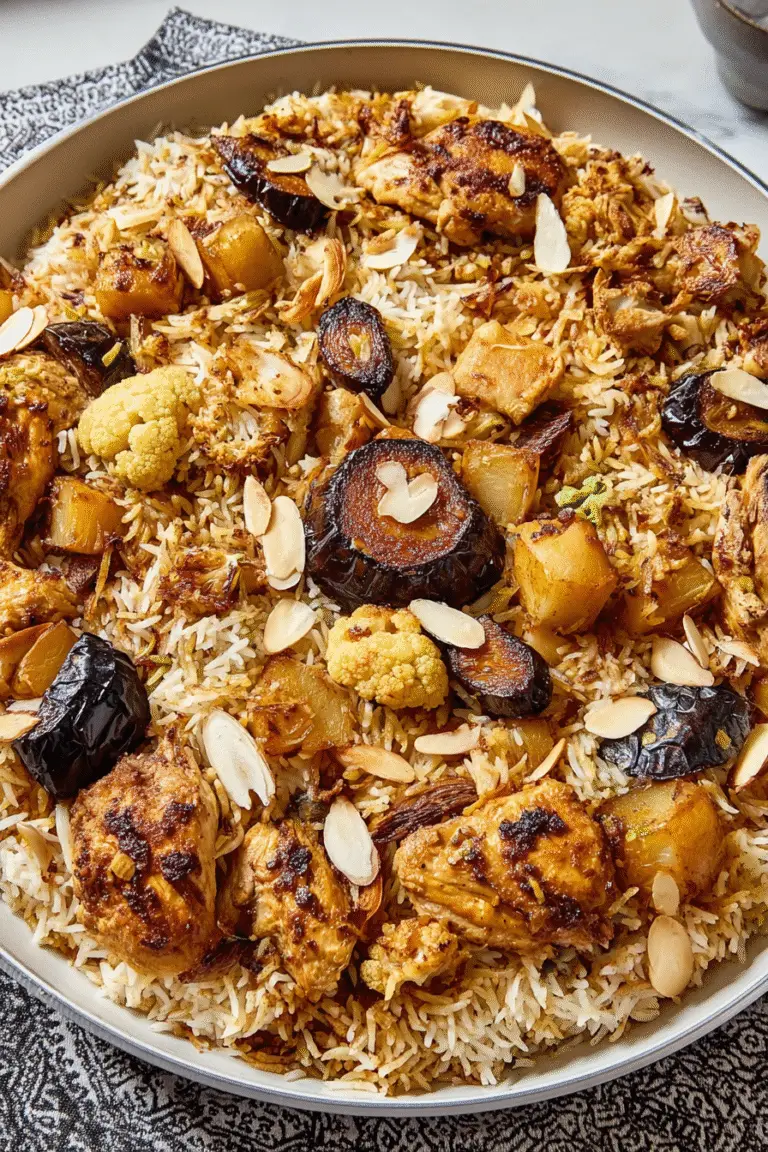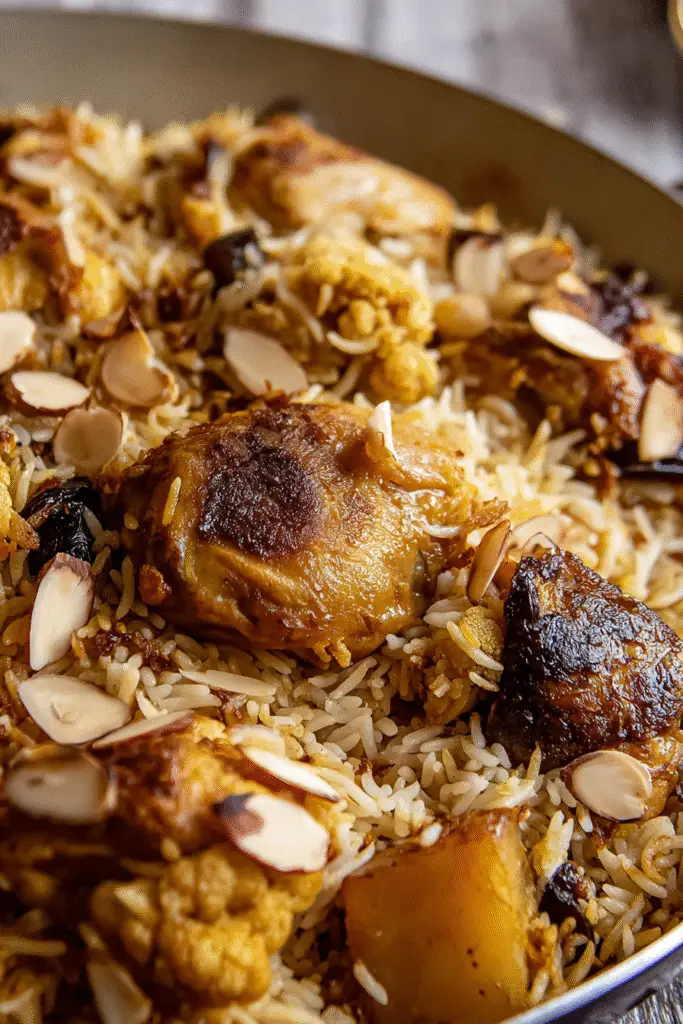Few recipes carry as much drama and beauty at the dinner table as Maqluba au poulet.
Print
Maqluba au Poulet – The Iconic Upside-Down Chicken Rice Dish
Maqluba au poulet is a stunning Middle Eastern one-pot dish where chicken, rice, and vegetables are layered, cooked in fragrant spices, and flipped upside-down for a dramatic reveal. Perfect for family dinners or gatherings, this recipe combines tradition with flavor in every bite. Try it at home and wow your guests today!
- Total Time: 1 hour 50 minutes
- Yield: 6
Ingredients
Ingredients
For the chicken & broth:
1 whole chicken (3 lbs), cut into 6–8 pieces
1 large onion, quartered
6–8 cardamom pods
2 bay leaves
Salt, to taste
Water, to cover
For the vegetables:
2 medium eggplants, sliced into rounds
1 medium cauliflower head, cut into florets
2 medium potatoes, peeled and sliced
2 medium carrots, sliced into rounds
3 tablespoons vegetable oil (for frying)
For the rice:
3 cups basmati rice, rinsed and soaked 30 minutes
5 cups chicken broth (reserved from boiling chicken)
1 tablespoon ground cumin
1 tablespoon ground coriander
1 teaspoon turmeric
1 teaspoon cinnamon
1 teaspoon allspice
½ teaspoon black pepper
For garnish:
½ cup toasted almonds or pine nuts
2 tablespoons fresh parsley, chopped
Instructions
Prepare Chicken & Broth:
In a large pot, place chicken pieces, onion, bay leaves, cardamom, and salt. Cover with water, bring to a boil, skim foam, and simmer for 40 minutes. Strain and reserve broth.Fry Vegetables:
In a pan, heat vegetable oil. Fry eggplant slices until golden, drain on paper towels. Repeat with cauliflower, potatoes, and carrots.Season Chicken:
Remove boiled chicken, pat dry, rub with spices, and sauté lightly in olive oil until browned.Layer the Pot:
In a non-stick Dutch oven, layer chicken at the bottom. Add fried eggplants, cauliflower, potatoes, and carrots. Top with drained rice.Add Broth & Cook:
Pour 5 cups of hot broth over the rice. Cover tightly, bring to a boil, then simmer on low for 40 minutes until rice absorbs liquid. Rest 10 minutes.Flip & Serve:
Place a large platter over the pot. Invert quickly and carefully. Lift pot slowly to reveal layered Maqluba. Garnish with nuts and parsley.
Notes
Soak rice for fluffier grains and better texture.
Rest the pot before flipping to help layers hold.
Swap chicken for lamb or go vegetarian with extra veggies.
Serve with plain yogurt or a cucumber-tomato salad.
- Prep Time: 30 minutes
- Cook Time: 1 hour 20 minutes
- Category: Main Dish, Dinner
- Method: One-Pot, Stovetop
- Cuisine: Middle Eastern, Palestinian, Jordanian
- Diet: Halal
Literally meaning “upside-down” in Arabic, this layered dish of chicken, rice, and vegetables is a Palestinian classic also enjoyed across the Levant, including Jordan, Syria, and Lebanon.
Its unique presentation—an aromatic pot of rice and chicken flipped onto a platter in one grand motion—makes it both a feast for the eyes and the palate.
In this article, you’ll learn everything you need to prepare a perfect Maqluba at home: the authentic method, detailed ingredients, clear instructions, cultural context, and professional tips to get that flawless “flip.” By the end, you’ll not only have a delicious recipe but also a story to tell when you share this dish with friends and family.
The Story Behind Maqluba au Poulet
The dish has been cooked in the Middle East for centuries. Its earliest mentions appear in medieval Arabic cookbooks. Traditionally, Maqluba is prepared on special occasions, family gatherings, and holidays because of its celebratory look and layered richness.
The brilliance of Maqluba lies in its simplicity: humble ingredients like rice, chicken, cauliflower, eggplant, carrots, or potatoes are stacked, spiced, simmered, and finally flipped. When unveiled, the dish resembles a savory cake decorated with golden chicken pieces and tender vegetables.
Ingredients for Maqluba au Poulet
For 6 servings:
- 1 whole chicken (about 3 lbs), cut into 6–8 pieces
- 3 cups basmati rice, rinsed and soaked in water for 30 minutes
- 2 medium eggplants, sliced into rounds
- 1 medium cauliflower head, cut into florets
- 2 medium carrots, peeled and sliced into rounds
- 2 medium potatoes, peeled and sliced into rounds
- 1 large onion, quartered
- 4 tablespoons olive oil
- 3 tablespoons vegetable oil (for frying vegetables)
- 5 cups chicken stock (from boiling the chicken)
- Salt, to taste
Spice Blend:
- 1 tablespoon ground cumin
- 1 tablespoon ground coriander
- 1 teaspoon turmeric
- 1 teaspoon cinnamon
- 1 teaspoon allspice
- ½ teaspoon ground black pepper
- 2 bay leaves
- 6–8 cardamom pods
Garnish:
- ½ cup toasted almonds or pine nuts
- Fresh parsley, chopped
Step-by-Step Instructions
1. Prepare the Chicken
Place the chicken pieces in a large pot with onion, bay leaves, cardamom, a pinch of salt, and water to cover. Bring to a boil, skim the foam, then simmer for 40 minutes until cooked. Strain the broth and reserve—it will be your cooking liquid.
2. Fry the Vegetables
While the chicken simmers, heat vegetable oil in a wide pan. Lightly fry the eggplant slices until golden, then drain on paper towels. Repeat with cauliflower florets, carrots, and potatoes. This frying step ensures the vegetables hold shape during cooking.
3. Spice the Chicken
Once the chicken is boiled, remove from the broth, pat dry, and rub with the spice blend. Lightly sauté the chicken in olive oil until browned on all sides. This adds depth of flavor.
4. Layer the Pot
In a large non-stick Dutch oven or deep pot, start layering:
- Chicken pieces at the bottom
- A layer of fried eggplants
- A layer of fried cauliflower, carrots, and potatoes
- Top with drained rice
Press gently to compact the layers.
5. Add Broth
Pour 5 cups of the hot chicken broth over the rice until just covered. Do not stir. Cover tightly with a lid.
6. Cook
Bring to a boil over medium heat, then reduce to low and cook for 40 minutes until rice is tender and liquid absorbed. Let rest for 10 minutes.
7. The Flip
Place a large serving platter over the pot. Hold tightly with oven mitts, then flip the pot upside-down in one confident motion. Lift the pot slowly to reveal the layered Maqluba.
8. Garnish & Serve
Sprinkle with toasted nuts and parsley. Serve hot with fresh yogurt or a cucumber-tomato salad.
Tips for Perfect Maqluba
- Rice: Use long-grain basmati for a fluffy texture that doesn’t clump.
- Non-stick pot: A well-oiled, heavy pot helps the “flip” succeed without sticking.
- Rest before flipping: Letting the dish rest ensures the rice sets and layers hold.
- Custom vegetables: Some families add zucchini or bell peppers—adapt to what you love.
- Broth ratio: Too much liquid can make it soggy, too little leaves rice undercooked.
Variations
- Maqluba with Lamb: A traditional alternative using lamb shanks or cubes.
- Vegetarian Maqluba: Skip the chicken and increase the vegetables for a lighter, plant-based version.
- Tomato Base: Some cooks line the bottom with tomato slices for color and tang.
Cultural Context
In the Levant, Maqluba is more than food—it’s an event. Families often gather around as the cook flips the pot, holding their breath until the dish is revealed. Its presentation makes it a centerpiece of festive tables, weddings, and Eid celebrations.
The act of flipping is symbolic too: turning humble ingredients “upside-down” into a glorious feast speaks of transformation, abundance, and shared joy.
Nutrition (per serving, approximate)
- Calories: 620
- Protein: 35 g
- Carbohydrates: 72 g
- Fat: 20 g
- Saturated Fat: 5 g
- Fiber: 6 g
- Sodium: 820 mg
Pro Tips for Hosting with Maqluba
- Serve with a tangy yogurt dip or cucumber salad to cut richness.
- Pair with mint tea for an authentic Middle Eastern dining experience.
- Prepare the layers ahead of time; assemble and cook before guests arrive.
Final Thoughts
Maqluba au poulet is more than just a recipe—it’s a culinary performance. Each spoonful brings together fragrant rice, tender chicken, and crisp vegetables, unified by warm spices. With practice, you’ll master not only the taste but also the dramatic unveiling that makes this dish legendary.
If you’ve been looking for a recipe that’s both comforting and impressive, this is it. Gather your ingredients, set aside some time, and try your hand at this upside-down marvel. Once you serve it, you’ll understand why Maqluba has endured for centuries as a symbol of generosity and hospitality in Middle Eastern kitchens.

